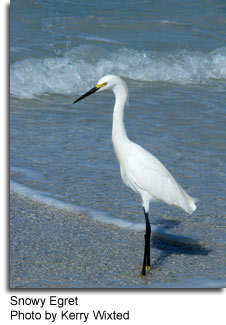Snowy Egret
(Egretta thula)
 Description & Range
Description & Range
One of Maryland’s most beautiful water birds, the snowy egret is an entirely white feathered, medium-sized wader common to the Chesapeake Bay and coastal areas. Similar in appearance to, but smaller than its cousin the great egret, snowy egrets are most easily recognizable by the delicate, lacy plumes they sport on their heads, necks and backs. They have black legs with bright yellow feet and slender black bills with a yellow upper portion of the bill that turns red during the breeding season. Male and female snowy egrets look alike.
Snowy egrets are considered colonial water birds as they commonly nest in large colonies with other wading birds.
Snowy egrets are found along much of the East Coast, wintering from the Carolinas southward. Their main foods are fish, crabs, amphibians, and insects.
Habitat:
The snowy egret inhabits marshes, swamps, ponds, shores, and tidal flats.
Diet:
Fish, frogs, crawfish, and other aquatic life
Snowy_Egret_RB.jpg
Reproduction:
They breed once a year and females lay three to five greenish-blue eggs that hatch in 21 to 28 days. Their platform-like nests are built primarily of twigs and are located in low tree canopies or along the ground.
Sounds:
Low croak to a bubbling wulla-wulla-wulla
Similar Species:
- Great Egret
- Little Blue Heron (juvenile)
- Reddish Egret (white morph)
The snowy egret is also known as the lesser egret, little snowy, little white egret and little white heron. Should you see a white egret at a distance and you’re not sure what type it is, remember that snowy egrets have black beaks and yellow feet while great egrets have yellow beaks and black feet!
Management:
In the latter part of the 19th century, snowy egret plumes were very popular on ladies’ hats, and the birds were hunted nearly to the point of extinction. While populations rebounded through the 20th century, colonial water birds such as the snowy egret are still considered Wildlife Species of Greatest Conservation Need and DNR’s Natural Heritage Program monitors their populations closely.